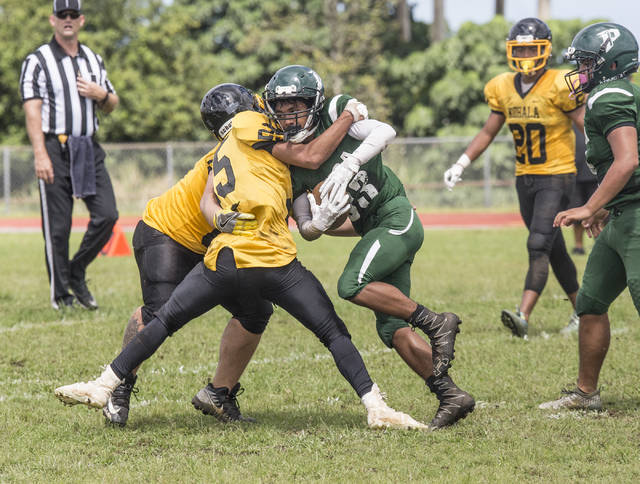With eight-man defections, BIIF expands to 11 football teams

Pahoa High was the last team to win a game in the five-year history of BIIF eight-man football, the only of three teams not to win a championship, and the first one to leave.
Pahoa High was the last team to win a game in the five-year history of BIIF eight-man football, the only of three teams not to win a championship, and the first one to leave.
The Daggers never stopped dreaming of higher aspirations as they steadily improved, and spearheaded by athletic director Hoku Haliniak and coach Chris Midel, the school decided to take the leap to 11-man, effectively taking Ka’u and Kohala with them.
ADVERTISING
With eight-man dissolved, the BIIF is set to have 11 football members for the first time since the league began sponsoring the sport in 1956.
“This was always the ultimate goal,” said Midel, who started the Daggers’ eight-man program in 2014. “We finally felt we could keep up.”
Pahoa made its intentions official at an athletic directors meeting Tuesday, forcing the hand of the Trojans, whose coach had long hinted he wanted to move up, and the Cowboys, who were more wary of the development.
Kalei Namohala, the BIIF football coordinator and the AD at Ka’u, said three schools are needed for the league to sanction the sport. The expansion from eight to 11 football teams leaves many details to be hammered out in the coming months, including scheduling, divisional alignment and finding enough on-field officials for an apparent expansion of the schedule.
The BIIF featured 10 teams from 2004, when Kamehameha entered, until 2012, when Ka’u and Kohala dropped out. The addition of three Division II schools would ostensibly offset the divisional balance, putting seven in D-II to go along with four in D-I.
“The big schools are still going to be the big schools,” Namohala said. “No one has (declared) what division they intend to be in yet.”
After Ka’u won its third eight-man title in a row in October with a 6-0 record, Trojans coach DuWayne Ke said his program would strongly consider returning to 11-man, and he sounded gung-ho Wednesday.
“It’s going to be an exciting year,” Ke said. “I think the community is ready for it.”
Ka’u started the 2018 season with 40 players and ended it with 33 and would appear to be the best equipped to make the move up. Pahoa ended the season with 25 players after starting with 32, and the Cowboys had 23.
All three of the coaches, including Kohala’s Chad Atkins, said they thought fielding conventional football would be a boost for player recruitment.
“More will want to stay at Pahoa instead of (transferring) to go play 11-man,” Midel said. “I’ll have to get out to the charter schools” to recruit players.
Pahoa last played BIIF football in 2001 before taking a 13-hear hiatus. The Daggers were winless in 2014 and ‘15, but they were runners-up the past two seasons.
“We slowly improved to the point that we thought we could make a move and compete,” Midel said.
Still, competitive imbalance is sure to be an issue on the minds of many coaches and administrators, just as it was in 2012, the last season in which Ka’u and Kohala fielded full teams. Kohala absorbed a 76-0 loss to Konawaena and dropped out midseason – citing, in part, player safety – and Ka’u followed suit after a campaign that ended with a 91-8 loss to the Wildcats and a 78-0 defeat against Honokaa.
“I’m not necessarily opposed to it,” Konawaena coach Brad Uemoto told West Hawaii Today, “but the whole 8-man league was created because there was so much disparity between teams and the number of players. Unless something has drastically changed for Pahoa, Kohala and Ka‘u, I could see it ending in the same scenario.”
For a handful of seasons through 2012, four Division I teams and the six from D-II played exclusively within their division, matching up twice against one another, meaning D-II teams had 10 league games.
For the past six seasons, BIIF teams were scheduled to play once during a seven-week schedule. Obviously, that will have to be scrapped, but just how remains top be seen.
In 2018, eight-man teams played four-game league schedules, followed by a semifinal and championship game.
The Cowboys went winless, scoring 32 points in five games, in their first year under the helm of Atkins, who said he started recruiting players at a Kohala basketball game Tuesday night.
“I talked to Laurie (Koustik) our AD and asked if we were moving up,” Atkins said. “She said we had to.”
“I’m kind of excited,” he said, “but I’m going to need more players and more coaches if we’re going to be playing against the big boys. There is going to be an adjustment period.”
Atkins was an assistant on the 2015 Kohala team that went undefeated in winning its lone eight-man title, and he estimated that team could have been competitive with Honokaa and Hawaii Prep.
“We had kids who could compete, but I think our numbers for us would have been a downfall,” he said. “At the end of the day, we can have all skill on the world, but it doesn’t matter if you’re getting beaten up.”
Namohala echoed some of those sentiments, contrasting the “beatings” the Trojans took in 2012 to the eight-man dynasty that followed in the years to come.
“I liked eight-man because the small schools could be competitive,” she said. “I hope people understand why we had eight-man.
“The most important thing is we still have football.”
West Hawaii Today’s J.R De Groote contributed to this report.


